Exercises (3201)
Balance artist
Coordination exercises
Individual work
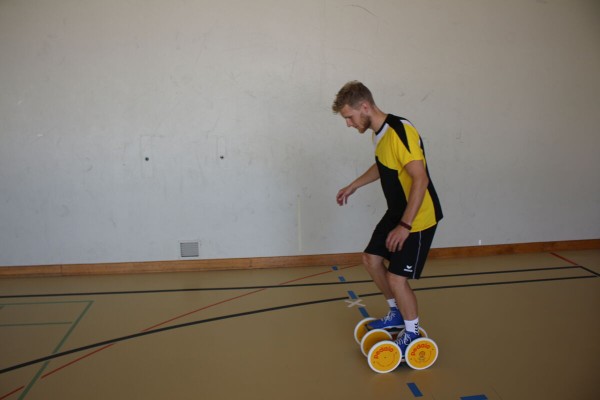
Running a certain distance standing on a running board with wheels.
Difficulty:
Running backwards.
Variant:
Race between group members over a specified distance. On contact with the ground, the respective participant must move back by 2 metres.
► Balance ability
1 footboard with wheels
Balance artist
Coordination exercises
Individual work

Sit on the exercise ball, raise your arms and legs slightly and keep your balance (floating position).
Variant:
Take a kneeling or even standing position on the exercise ball.
►Balance ability
1 exercise ball
Balance artist
Coordination exercises
Individual work

The participant positions themselves in front of the long bench, fixes a point on the ceiling or floor and quickly rotates around their own axis 5-10 times before balancing over the long bench immediately afterwards.
► Orientation skills, balance skills
1 Longbank
Balancieren
Parkour
Partner work
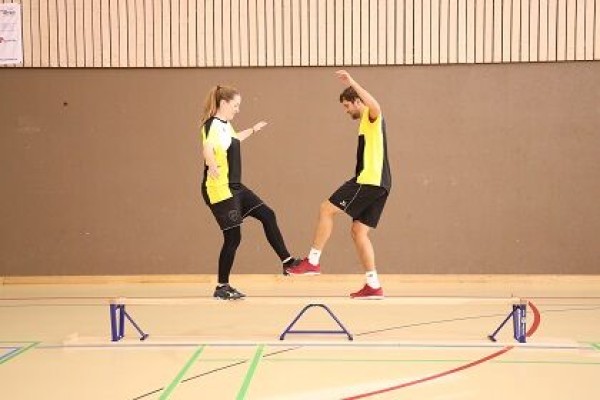

Two participants stand on one leg on the narrow side of a long bench and face each other head-on (stand on a wall, ground line or other elevation ►outdoor version), pressing the inside of the foot of the free leg (also possible with the outside edge of the foot) against the foot of the other person, then trying to push their partner off the bench without losing their balance. Switch legs from time to time.
1 long bench
Indoor post setup:
Narrow side of the long bench points upwards.
Outdoor:
Narrow wall, ground line or other elevation.
Balancieren
Parkour
Individual work
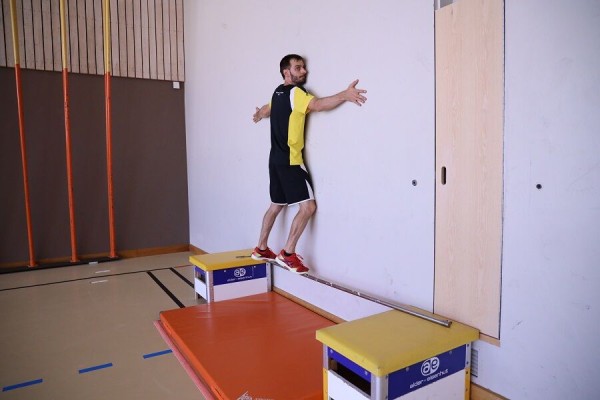
Balance over the horizontal bar from one side of the vaulting box to the other
.2 vaulting boxes
1 horizontal bar
1 soft mat (small)
Post structure:
Place two vaulting boxes (2 elements each incl. top section) on a wall approx. 1.5m apart, place a horizontal bar over the two top sections.
Balancieren
Parkour
Individual work

Balance over the horizontal bars from box to box top.
Variations:
Integrate jumps;
Include 180 and 360 degree turns.
outdoor:
Balance on a narrow ledge and incorporate jumps and 180 or 360 degree turns.
3 vaulting box (upper parts)
2 horizontal bars
Post structure indoor:
Three vaulting box upper parts are placed on the floor and connected with horizontal bars.
outdoor:
a narrow bar/raiser.
Balancieren
Parkour
Individual work
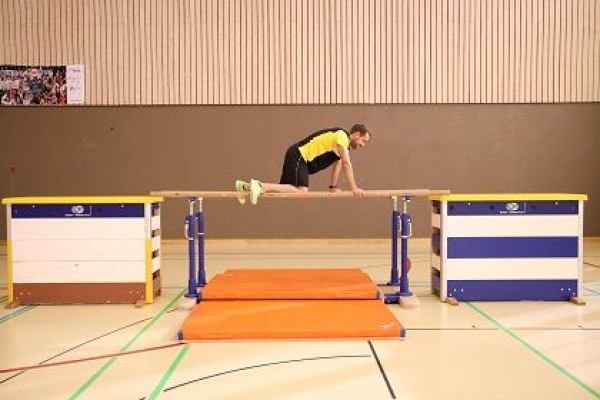
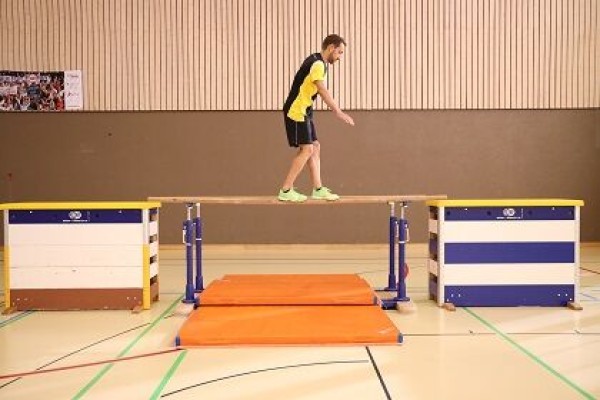
Moving from one vaulting box to the other by crossing the bar on all fours or in an upright position.
1 parallel bars
2 vaulting boxes
2-4 soft mats (small)
Post setup:
Set up two vaulting boxes with a parallel bar in between (lengthwise).
Balancieren
Parkour
Individual work
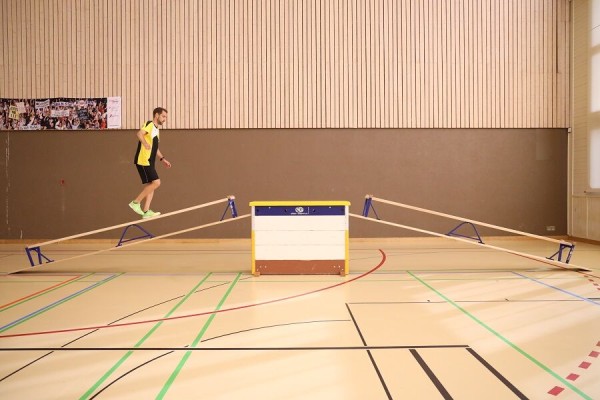
Balancing over the long benches and the vaulting box from one side to the other.
Variations:
Change direction of movement (fw./rw.);
Change type of movement (upright/on all fours);
Change speed.
outdoor:
Walk along a pole or narrow wall in a four-foot stance.
Variant:
Walk backwards.
1 vaulting box ► indoor version
2 long benches ► indoor version
Indoor post setup:
Hook two long benches with the narrow side facing up at both ends of a vaulting box.
outdoor:
Pole or narrow wall.
Balancieren
Parkour
Individual work


Balancing over long benches and medicine balls from one side to the other.
Variations:
Jumping with one leg from ball to ball;
Jumping with 180 degree turns from ball to ball.
outdoor:
Standing frontally on the pole (e.g. barrier, fence) and balancing. The second person provides assistance so that no one falls.
Variations:
Stand sideways;
Walk on the pole.
2 long benches
3 medicine balls
Indoor set-up:
Three medicine balls lie between two upturned long benches (narrow side facing upwards) at a slight distance from each other.
Outdoor:
A very narrow surface.
Ball circuit
Stimulate circulation
Group work
2 groups
One participant from group A throws the ball into the hall/area, then his group A forms a "Kneuel", one participant from this group A runs round the "Kneuel". Group A counts the number of laps out loud. The other group B runs as fast as possible to the ball. The first participant in group B to reach the ball lifts it up and the other participants in group B line up behind them in a column. The ball is now passed overhead to the last participant in group B, who shouts "stop" as soon as they receive the ball. Group A, which has counted the laps in the meantime, now tells everyone the number of laps. The roles are swapped for the next round.
1 exercise ball/kin-ball
Supply balls
Increase pulse
Group work
2 teams
One group has its goals (e.g. vaulting box elements, tyres or soft mats) in the corners of the pitch, the other group in the middle of the pitch. The aim is to put as many balls as possible into the opposing team's goal by taking the balls from their own goals. Only one ball may be carried per run (if necessary, define the method of transporting the ball: carrying, bouncing, dribbling or rolling). Which group has fewer balls in the goal after a certain time?
8 Swedish box parts
x balls (various)
1 stopwatch
Capturing the ball
Fighting and roughhousing games
Partner work

Two participants grab a ball with both hands. The participants try to snatch the ball from their opponent. Whoever captures the ball wins.
1 ball (e.g. volleyball, softball, handball, basketball, football)
Capturing the ball
Fighting and roughhousing games
Partner work
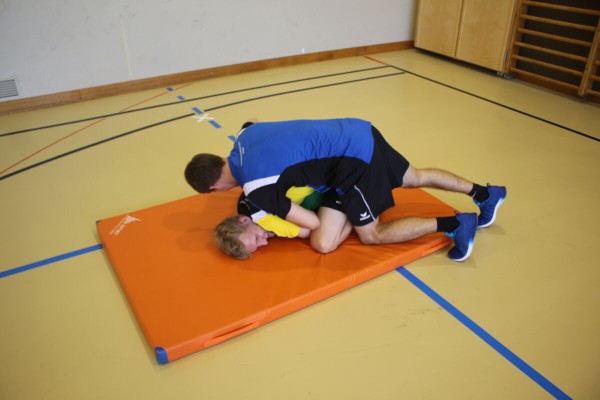
One participant tries to shield a ball as well as possible from their opponent (e.g. burying the ball underneath them in a four-footed stance). The opponent tries to steal/steal the ball from them.
Variant:
Stop time until the ball is successfully captured or set a time limit for the attempt.
1 soft mat (small) ►indoor version
1 ball (e.g. volleyball, softball, handball, basketball, football)
1 rash tent sheet ►outdoor version
1 stopwatch ►variations of the exercise
ball catcher
Coordination exercises
Individual work
One participant stands on the slackline, the partner on the floor. Now try to pass the ball back and forth as often as possible without the participant on the slackline falling off it.
Heavy:
Both participants stand on the same or different slacklines and try to pass the ball back and forth as often as possible.
1 Slackline
Ball retention
Stimulate circulation
Group work
2 teams
Two teams play against each other in a limited playing area. The team with the ball tries to keep the ball in their own ranks for as long as possible by passing the ball in accordance with the rules of the game (possibly prohibiting back passes). The opposing team tries to intercept the ball. If this is successful, the roles change. Depending on the form of play, roles/ball changes can also occur when the ball falls to the ground (both when a team-mate drops the ball and when an opponent knocks the ball to the ground/intercepts the pass), when the ball leaves the pitch or, if necessary, after a point has been scored.
Possibilities for winning points:
- 10 consecutive passes
- 30 seconds of successful ball retention
Variant:
The teams try to score as many points as possible in a given time. There is no change of roles/ball in this form of play
1 ball ►Basketball, FooBaSKILL, Futsal/Football, Handball, Intercross/Lacrosse, Smolball, Floorball
Participant:
1 stick/stick ►Intercross/Lacrosse, Smolball, Floorball
One group:
x wristbands/bibs ►Team identification
Sport leader:
1 stopwatch
Ball artist
Coordination exercises
Individual work
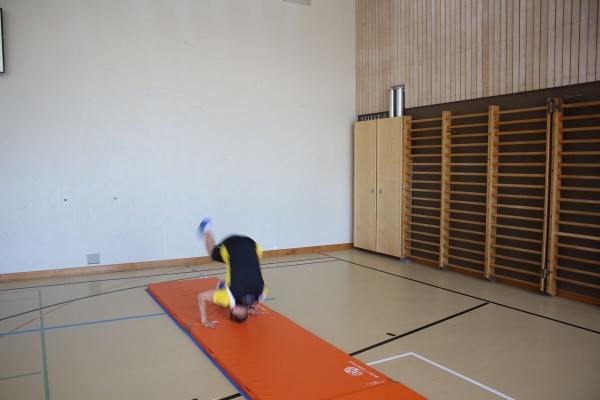
The participant stands at the beginning of the row of mats and throws a soft/foam/volleyball high into the air. The participant then performs a forward roll and tries to catch the ball directly out of the air while standing.
Variant:
Roll backwards; two rolls etc.
►Orientation skills, differentiation skills
4 soft mats (small) ► indoor version
1 soft/foam/volleyball
Turf pitch ► outdoor version
Indoor post set-up:
Using small soft mats to form a row of mats.
Ribbon relay
Increase pulse
Group work
4-5 participants per group
One runner runs around a turning point (e.g. colouring stick, marker cone or cone) or to the hall wall and back before handing the ribbon to the next runner and sending them on their way. There are various ways of practising with the ribbon:
Single run:
- Clamp the ribbon between the knees
- Clamp the ribbon between the feet and move around hopping
- Carry the ribbon on your chest without holding on to it with your hands
With a partner:
- One participant in the push-up position places their feet on the ribbon, which their partner is holding (garette) and moves away with their hands. The participant who kept their feet in the air with the ribbon becomes the next runner (push-up position) at the handover
- Tuck the ribbon back to back
Replacements: Run around the waiting group back to the next runner for the game ribbon handover - pass the game ribbon forwards between the legs - pass the game ribbon forwards over the heads
.Per group:
2 colouring sticks
1 game ribbon
Bench push
Fighting and roughhousing games
Partner work
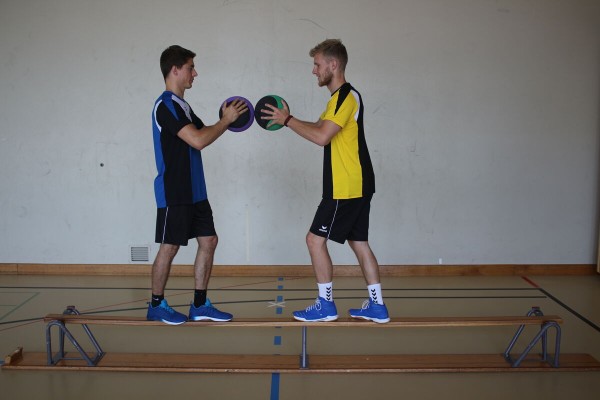
Two participants stand opposite each other on the narrow side of a long bench (possibly raised using Swedish boxes) and each hold a medicine ball in their hands. The participants try to push each other off the long bench with the medicine balls. Whoever touches the ground first loses.
1 long bench
2 medicine balls
2 vaulting boxes ►Variation/making the exercise more difficult (post set-up)
Post set-up:
Position the long bench with the narrow side facing up (possibly hang it on the side of two vaulting boxes so that the long bench is raised off the ground).
Basketball
Games / Tournament
Game idea:
Quick and accurate passing of the ball in front of the opponent's basket and a final attack with a direct throw into the basket or via the board. The opposing team has the task of fending off the attack, gaining possession of the ball and going on the attack itself.
Scoring points:
A basket from the field counts as 2 points. A successful shot from beyond the 3-point line scores 3 points. A sunk free throw scores 1 point.
Court:
Basketball court (15mx28m), basket with rebound board. Basket height 3.05m
Number of participants:
5 against 5
Game rules:
The game starts with a bouncing ball in the centre of the court. If the ball leaves the court, the opposing team returns it into play with a throw-in from the edge of the court. After a point is scored, the right to attack changes and the ball is brought back into play with a throw-in from the baseline on the side of the scorer (except in the case of several free throws). If the attacking team has crossed the halfway line and is in the opponent's half of the court, it may not return the ball to its own half.
The game is played largely without physical contact. A maximum of one step may be taken with the ball in the hands without bouncing or passing (step fault). So-called doubles are also prohibited (catch-bounce-catch-bounce). Star steps are permitted with the ball in the hands (one leg remains firmly on the ground). If the shooter is obstructed, they are allowed free throws (2 inside or 3 free throws outside the 3-point line).
There are several rules for time violations in basketball. For example, you have a maximum of 24 seconds for an attack, whereby you must have crossed the centre line within 8 seconds. No player on the team in possession of the ball may stay in the opponent's restricted zone (trapezoid between the baseline and the free-throw line) for longer than 3 seconds. You have 5 seconds to get the ball back into play after winning a point or leaving the court.
Basketball relay
Increase pulse
Group work
5-6 participants per group
The distance to the basketball hoop is the same for all groups. The first participant in each group bounces to the basket, where they sink the ball (until successful). He then runs behind his own group. The ball is passed in a snaking line (once over the head, once between the legs) to the foremost participant, who starts as soon as he has received the ball. Once all participants in the group have hit the basket (once or several times), the group sits down.
Per group:
1 basketball
1 basketball hoop
Basketball pursuit
Stimulate circulation
Group work
6-8 participants per group
The group lines up in a column at the free-throw line in front of the basketball hoop. The first two participants in the line have a ball. The first participant shoots at the basket. After this throw, the second participant may also try to put the ball in the basket. Both players throw until the ball lands in the basket (only the first throw is from the free throw line). If the player behind hits the ball first, the player in front is eliminated (possibly introduce additional exercises such as forearm support for the eliminated participants). If the person in front hits the ball first, he hands it to the next participant in the group. This person can now try to eliminate the person in front of them. In the final, the last two remaining players compete against each other. Without rallying, they try to overtake the player in front. The winner receives a point and then the group lines up again in turn (winner starts).
Variant:
No players are eliminated. If a player behind scores first, they receive a point. The order of the participants should be changed regularly. The winner is the player who has scored the most points after a certain time.
1 basketball hoop
2 balls ► Basketball, FooBaSKILL
Basketball pursuit
Increase pulse
Group work
5-8 participants per group
The participants line up at the free-throw line in a single collone, with the two foremost participants in possession of the ball. The first participant throws the ball from the free-throw line to the basket. If he scores, he immediately passes the ball to the next participant in the column without the ball. Otherwise, he throws the ball at the basket in compliance with the baseball rules until a hit is made before he can hand the ball to the next thrower. From the first throw of the person in front, the second participant may also attempt to score a basket with the ball. If the person in the back makes a successful attempt faster than the person in front, the person in front is eliminated. If the person in front scores first, the game continues and the ball is passed to the next thrower until the person in front is overtaken by the person behind. At the end of the game, only two throwers duel, who take the ball again after a successful basket shot and, starting from the free throw line, try to catch up with the person in front. As soon as a winner has been chosen, all participants line up again in the column (if necessary according to the ranking of the preliminary round) to start a new round. The sports director may define an additional task for participants who have already been eliminated (e.g. wall sit, global forearm support, side support).
Per group:
1 basketball hoop
2 basketballs
Basketball: All against all
Forms of play / exercises
Group work

Half of the players have a ball. They are attackers. The other players are defenders. The attackers can shoot at all baskets, but only once in a row at the same basket.
Each defender can get a ball at any point in the court by defending according to the rules. After a successful basket shot, the attacker retains possession of the ball. Everyone counts the number of baskets scored in a given time.
Objective: Intensive practice of technical and tactical elements
x basketballs
6 basketball hoops
Basketball: Joker game
Forms of play / exercises
2 Teams

Two teams play for all available baskets in the entire hall. The aim is to score baskets in the opponent's half of the court. A player - the joker - waits behind the baseline and may be included in the attack. However, the joker may not cross the baseline.
Objective: Good free running, intensive passing and man-to-man defence
1 basketball
6 basketball hoops
x game wristbands / covers ►team labelling
Basketball: slalom and basket shot/cage shot
Forms of play / exercises
Group work

The participants bounce the ball through a slalom course consisting of colouring sticks and then perform a basket shot or basket shot. The throwing stations are defined with cones, the cones close to the basket indicate a basket shot.
Additional strengthening task:
Those who do not sink the ball into the basket complete a strength exercise: 10x rotation of the upper body in a sitting position (russian twist)
1 basketball hoop
2-4 basketball balls (depending on the number of participants)
6 colouring sticks
8 marker cones